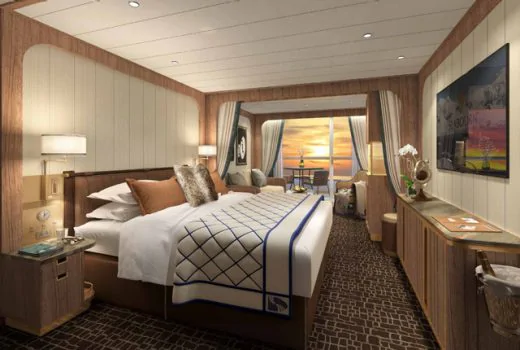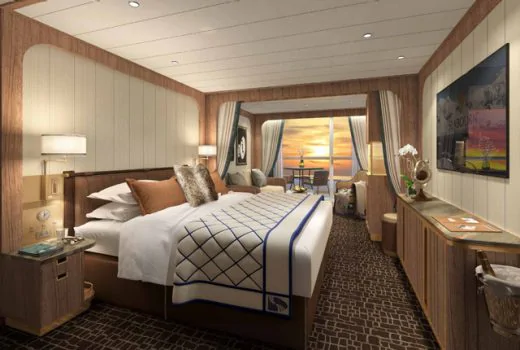Andalusian Nights & Barcelona Open
- 13 Apr ‘25
- 17 nights
- Departing from Civitavecchia (Rome)
- Seabourn Venture
-
Inside price fromCall for price
-
Outside price fromCall for price
-
Balcony price from$16,199*/pp
-
Suite price from$33,679*/pp
YOUR ITINERARY
Civitavecchia (Rome), Italy - Portoferraio, Italy - Portovenere, Italy - Cannes, France - St Tropez, France - Sete, France - Barcelona, Spain - Barcelona, Spain - Sete, France - Palamos, Spain - Mahon, Spain - Motril, Spain - Tangier, Morocco - Portimao (Algarve) - Portugal - Lisbon, Portugal
Originally built by Emperor Trajan who had a villa here, Ci...
Originally built by Emperor Trajan who had a villa here, Civitavecchia has flourished as a major port for Rome since the 13th century. Today it is an important ferry terminal and for many travelers the gateway to the Eternal City, Rome. The Renaissance fortifications that surround the harbor area were begun by Bramante and completed by Michelangelo in 1535.
Despite its small size, the island of Elba has been known si...
Despite its small size, the island of Elba has been known since the beginning of recorded history. Called Ilva by the Ligurians and Aethalia by the Greeks, Elba passed to the Etruscans and later the Romans. It was ruled by Pisa in the Middle Ages, was a haven for Barbary pirates in the 16th century and then privately owned by the powerful Medici family. The island’s most famous resident was Napoleon Bonaparte, whose first exile from France and short reign over Elba lasted from May 1814 to February 1815. During that time, Napoleon was able to improve the island by altering street plans, building new roads, modernizing agriculture and developing the iron mines.
Iron ore is still mined above the Rio Marina and then shipped from Portoferraio (Port of Iron). With a population of just over 11,000, the town is the largest of the eight on the island and is considered its capital. Geologists and gem stone collectors find Elba a treasure trove with over 150 minerals and semiprecious stones found here due to the seismic turmoil that created the island. The rich soil also produces an astonishing range of foliage and flowers aided by sun that shines almost every day of the year. Despite summer tourism, the island is largely agricultural and the ambience is quiet and relaxed, allowing the visitor to enjoy Elba’s natural charm, peaceful abundance and timeless beauty.
The Gulf of La Spezia has been so frequent a subject ...
The Gulf of La Spezia has been so frequent a subject for poets over the years – from Dante and Petrarch to Byron and Shelley – that it is often referred to as the Golfo dei Poeti. The elongated yellow and orange houses, which line the harbor stretch up the steep slope toward ancient battlements beyond. Mentioned as a landing place in Claudius Ptolemy’s “General Geography” (150 AD), today Portovenere is a resort with a friendly and relaxed atmosphere.
Cannes was founded in the 2nd century BC by a Ligurian...
Cannes was founded in the 2nd century BC by a Ligurian tribe, and was subsequently colonized by the Romans in 154 AD. During the town’s entire history it went through a period of upheaval and desolation by war. In 1834, Lord Brougham, an English aristocrat, was so enchanted by Cannes that he decided to settle there. This marked the beginning of the town’s affluence, with luxury residences springing up to provide winter accommodations for international nobility. From 1930 onward, Cannes became a summer resort. Its local economy had traditionally relied on fishing, but was quickly replaced by tourism. Today, Cannes is best known for its world famous film festival and, for two weeks in May each year, attracts the brightest and most talented stars of the silver screen.
On the southern shore of one of the most beautiful bays of ...
On the southern shore of one of the most beautiful bays of the Riviera, the little port of St. Tropez has become one of the best known resorts in Europe, a crossroads where journalists, photographers, writers, artists and celebrities meet. Guy de Maupassant discovered the town, but it was the painters who made it more widely known – Signac, Matisse, Bonnard, Marquet, Camoin – who all stayed for varying amounts of time. The harbor teems with life. Fishing boats, excursion craft and hundreds of yachts share the harbor. On the waterfront are old pink and yellow houses, which have been converted into cafes, cabarets and restaurants, luxury boutiques, galleries and antique shops. A picturesque and cosmopolitan crowd strolls the streets in season.
The port town of Sete hugs the tiny Mont St. Clair...
The port town of Sete hugs the tiny Mont St. Clair, and is caught between the Mediterranean and the Bassin de Thau, a salt lake directly behind it. It is crisscrossed by numerous canals which link the lake to the sea, and connected by 12 bridges. Along the quay, renovated buildings provide a multitude of architectural details from the 18th and 19th centuries. The life of the town is found in its squares: Place Leon Blum, with its fountain and Wednesday morning flower market; Place Aristide, with its old fashioned bandstand; and Place de la Republique, with its huge retaining walls and vaulted loggias. Sete retains its historic purpose as a fishing boat haven for North African trade; the old harbor dates from the time of Louis XIV.
Barcelona, the capital of Catalonia, is said to have...
Barcelona, the capital of Catalonia, is said to have been founded by the Phoenicians, and was once the rival of the powerful states of Venice and Genoa for control of the Mediterranean trade. Today, it is Spain’s second largest city and has long rivaled, even surpassed Madrid in industry and commerce. The medieval atmosphere of the Gothic Quarter and the elegant boulevards combine to make the city one of Europe’s most beautiful. Barcelona’s active cultural life and heritage brought forth such greats as the architect Antonio Gaudi, the painter Joan Miro, and Pablo Picasso, who spent his formative years here. Other famous native Catalan artists include cellist Pau Casals, surrealist Salvador Dali, and opera singers Montserrat Caballe and Josep Carreras. Barcelona accomplished a long-cherished goal with the opportunity to host the Olympics in 1992. This big event prompted a massive building program and created a focal point of the world’s attention.
Barcelona, the capital of Catalonia, is said to have been ...
Barcelona, the capital of Catalonia, is said to have been founded by the Phoenicians, and was once the rival of the powerful states of Venice and Genoa for control of the Mediterranean trade. Today, it is Spain’s second largest city and has long rivaled, even surpassed Madrid in industry and commerce. The medieval atmosphere of the Gothic Quarter and the elegant boulevards combine to make the city one of Europe’s most beautiful. Barcelona’s active cultural life and heritage brought forth such greats as the architect Antonio Gaudi, the painter Joan Miro, and Pablo Picasso, who spent his formative years here. Other famous native Catalan artists include cellist Pau Casals, surrealist Salvador Dali, and opera singers Montserrat Caballe and Josep Carreras. Barcelona accomplished a long-cherished goal with the opportunity to host the Olympics in 1992. This big event prompted a massive building program and created a focal point of the world’s attention.
The port town of Sete hugs the tiny Mont St. Clair, and is caugh...
The port town of Sete hugs the tiny Mont St. Clair, and is caught between the Mediterranean and the Bassin de Thau, a salt lake directly behind it. It is crisscrossed by numerous canals which link the lake to the sea, and connected by 12 bridges. Along the quay, renovated buildings provide a multitude of architectural details from the 18th and 19th centuries. The life of the town is found in its squares: Place Leon Blum, with its fountain and Wednesday morning flower market; Place Aristide, with its old fashioned bandstand; and Place de la Republique, with its huge retaining walls and vaulted loggias. Sete retains its historic purpose as a fishing boat haven for North African trade; the old harbor dates from the time of Louis XIV.
Located at the foot of the mountains on SpainR...
Located at the foot of the mountains on Spain’s rugged Costa Brava, Palamos boasts seven superb beaches, Iberian archeological remains from the year 6 BC, and the Church of Sant Esteve on the beach. Highlighting the town center is its 16th-century cathedral.
Mahon is the capital of Menorca, second largest of the ...
Mahon is the capital of Menorca, second largest of the Balearic Islands. It stands out from the others because of the abundance of prehistoric structures, and because its culture was influenced by British occupation in the 18th century. The people who built the prehistoric constructions are believed to have been responsible for similar works in Sardinia, and for Stonehenge in England. Believed to have been founded by the Carthaginian General Mago, Mahon was held by the Moors from the 8th to the 13th century and in turn occupied by the English, the French and the Spanish. Mahon was finally ceded to Spain by the Treaty of Amiens in 1802.
This city of the Mediterranean coast is the second l...
This city of the Mediterranean coast is the second largest on the so-called Costa Tropical. But for us it is the port from which to ascend the slopes of the snow-capped Sierra Nevada to the ethereal Moorish city of Granada and the astounding complex of the Alhambra, the most beautiful display of Islamic architecture in Europe. Dramatically sited overlooking the city, the walled series of halls, courts, gardens and colonnades drip with airy carving and elaborate decorative reliefs that embody the term Arabesque. The sprawling Generalife Gardens adjoining the fortress are a memorable site unto themselves. Elsewhere in Granada, the Capilla Real is a purely Spanish Gothic building, holding the marble tombs of the Reyes Catolicos Ferdinand and Isabella behind a gilded wrought-iron screen.
Situated just across the narrow Strait of Gibralt...
Situated just across the narrow Strait of Gibraltar from Europe, Tangier has long comprised a hybrid culture that is nearly as European as it is African. Standing atop Cap Spartel, one can gaze down on the place where the Atlantic meets the Mediterranean. The “Hollywood” district where the foreign embassies have traditionally been located reflects the European influence. But ascending the hill above the waterfront, one enters the narrow, winding alleys of the Kasbah, the city’s oldest, most Moroccan section. Down the coast, nearby Tetouan retains a nearly untouched walled medina, with sections originally occupied by Andalusian, Berber and Jewish populations. It is small enough that visitors can explore it without risking becoming lost, making it a perfect choice as a UNESCO World Heritage Site.
Portugal’s southeast coast is a ruggedly be...
Portugal’s southeast coast is a ruggedly beautiful region, crowned by Cape St. Vincent, the southeastern-most point in Europe. At nearby Sagres, Henry the Navigator had his school where the most knowledgeable seamen in the world learned their craft. Standing on the high bluff overlooking the windy sea, one can imagine Columbus staring off to the west, pondering what lay beyond that blue horizon.
The great period of “the Discoveries” accounted fo...
The great period of “the Discoveries” accounted for phenomenal wealth brought back from India, Africa and Brazil by the great Portuguese navigators. Gold, jewels, ivory, porcelain and spices helped finance grand new buildings and impressive monuments in Lisbon, the country’s capital city. As you sail up the Tagus River, be on deck to admire Lisbon’s panorama and see some of the great monuments lining the river. Lisbon is one of Europe’s smallest capital cities but considered by many visitors to be one of the most likeable. Spread over a string of seven hills, the city offers a variety of faces, including a refreshing no-frills simplicity reflected in the people as they go unhurriedly through their day enjoying a hearty and delicious cuisine accompanied by the country’s excellent wines.
YOUR SHIP - The Seabourn Venture
Seabourn’s ultra-luxury purpose-built expedition ship Seabourn Venture, paying tribute to the remote destinations visited by the brand’s highly successful expedition and Ventures by Seabourn excursion programs and the fascinating places yet to be explored in the future.
Seabourn Venture is scheduled to launch in June 2021, with a second yet-to-be-named sister ship slated to launch in May 2022. Both ships will be designed and built for diverse environments to PC6 Polar Class standards and will include a plethora of modern hardware and technology that will extend the ships global deployment and capabilities. The new ships, which are being built by T. Mariotti, will be a brand new innovative design, created specifically for the ultra-luxury expedition traveler, and will include many features that have made Seabourn ships so successful.
A new and exciting offering will be two custom-built submarines carried onboard, providing an unforgettable view of the world beneath the ocean’s surface. The ships will also be designed to carry a complement of double sea kayaks, mountain bikes and ebikes as well as 24 Zodiacs that can accommodate all onboard guests at once, which will allow for a truly immersive experience. Each ship will feature 132 all veranda, all ocean-front suites.
Description
Seabourn’s ultra-luxury purpose-built expedition ship Seabourn Venture, paying tribute to the remote destinations visited by the brand’s highly successful expedition and Ventures by Seabourn excursion programs and the fascinating places yet to be explored in the future.
Seabourn Venture is scheduled to launch in June 2021, with a second yet-to-be-named sister ship slated to launch in May 2022. Both ships will be designed and built for diverse environments to PC6 Polar Class standards and will include a plethora of modern hardware and technology that will extend the ships global deployment and capabilities. The new ships, which are being built by T. Mariotti, will be a brand new innovative design, created specifically for the ultra-luxury expedition traveler, and will include many features that have made Seabourn ships so successful.
A new and exciting offering will be two custom-built submarines carried onboard, providing an unforgettable view of the world beneath the ocean’s surface. The ships will also be designed to carry a complement of double sea kayaks, mountain bikes and ebikes as well as 24 Zodiacs that can accommodate all onboard guests at once, which will allow for a truly immersive experience. Each ship will feature 132 all veranda, all ocean-front suites.
STATEROOMS

suite


